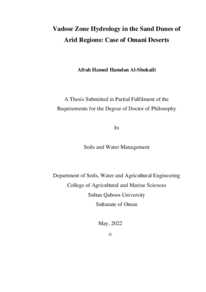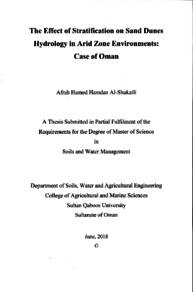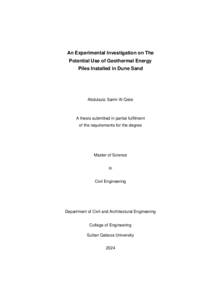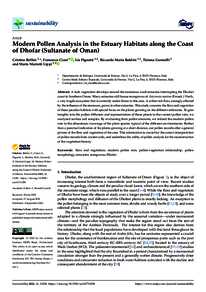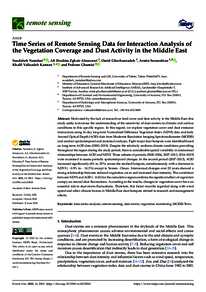وثيقة
Vadose zone hydrology in the sand dunes of arid regions : case of Omani deserts.
عناوين أخرى
الخصائص المائية للمنطقة الشعرية في الكثبان الرملية في المناطق الجافة : دراسة حالة من الصحاري العمانية
الناشر
Sultan Qaboos University.
ميلادي
2022
اللغة
الأنجليزية
الملخص الإنجليزي
Sand dunes in the deserts of arid regions, in particular, groundwater in aquifers
underlying the sand fields (e.g. Al-Sharqiyah Sands preciously known as
Wahiba Sands) has been studied since 1970th. However, several aspects of
dunes hydrology in Oman have not been investigated: the moisture storage and
fluxes in dunes' vadose zone, ecohydrology of vegetated dunes hillslopes, the
potential of using dune fields as sites of artificial recharge of underlying
aquifers, mimicking shapes and internal heterogeneity of natural dunes for
designing and engineering of dune-type porous composites as structures for
greening drylands.
The occurrence of scattered vegetation on the topsoil of desert sands in Oman,
despite the limited-sporadic rainfall pattern (<50 mm/year, 80% of it
evaporates), deserves special attention. Even in the harsh desert environment,
still, sparse vegetation survives on the dunes' slopes and interdunal areas.
Understanding the interplay between the vegetation spatial patterns and the soil
moisture in sand dune areas is important as it determines the ecohydrology of
the desert environment. In this thesis, the main objective was to study the
relationship between soil-moisture dynamics in the vadose zone of sand dunes,
giving special consideration to the capability of the sand dunes to act as
engineered self-irrigation units.
The diurnal pore water motion was studied in Ash Sharqiah Sands (linear dunes
separated by valleys, 1-2 km apart, the water table depth in wells located in the
interdental area is about 50 m under the valley, as of December 2018).
Vegetation pattern, density, and distribution were explored and described.
Measurements of volumetric moisture content ϴv were taken by 5TE sensors
(Decagon Devices) inserted at three different depths (5, 15, and 25 cm) across
four different locations (up-crest, crest, slope, and interdunal area), at an
interval of 125 m. Results have shown that denser and greener shrubs exist in
the upper part of the dune slope compared to the lower part.
In addition, a pilot investigation of the vadose zone and topsoil of small-size
coastal dunes (Nabkhas) of arid regions was done in Al-Hail North, Muscat.
The moisture content redistribution after a 13 mm rainfall event was monitored.
Three different Nabkhas, N1, N2, and N3, were investigated. The length (L)
and height (H) of each Nabkha were measured. Profile excavations were made
for three Nabkhas, and soil samples were collected. Decagon EC-05 sensors
were inserted at the depths (0, 20 cm) in the vertical excavations of N1, N2,
and N3 to monitor the diurnal variations of ϴv along with the Nabkha vertical
profile. The variation of ϴv shows a significant increase of ϴv in the top sensor
immediately after the rain event. While the bottom sensor has a trivial increase
with time. The value of ϴv in the top sensor kept increasing and reached the
maximum ϴv= 0.1 m3
/m3
on the last day of the rain event. This spatial and
temporal variation of ϴv in Nabkhas is also strongly affected by the
condensation of water from the humid ambient air and around the native
shrubs. Besides, it can catch and store the evaporated moisture from the
shallow water table beneath (i.e. in sabkha landforms).
Interdunal areas were explored and tested for managed aquifer recharge (MAR)
if natural wadis or small-size constructed channels are used as surface water
spreading systems. These channels would both transport and seep water into
the vadose zone and enhance the amount of moisture content there. A coupled
surface-subsurface flow was experimentally and numerically studied in
application to surface water harvesting through small-size channels. In the
field, experiments were done at the crest and slope of a selected dune,
triangular and rectangular channels. By applying a constant discharge at the
inlet of the channel, the length, L, of the water "jets" propagating until their
complete seepage extinction has been measured. Numerically, using
HYDRUS2D, saturated-unsaturated transient infiltration was simulated by
considering a cross-section of triangular channels of different bank slopes λ to
find the maximum total volume of infiltrated water from the channel.
Understanding the eco-hydrology of interior and coastal dunes, helped to
design mini-dunes (≤ 1 m in height) which were tested as sustainable irrigation
units. They can intercept moisture from humid air or even from the capillary
fringe and shallow water tables (e.g. in sabkha landforms). Thus, ornamental
plants or crops can be cultivated at the crest of the mini-dune with minimum
irrigation frequencies. Two SMDs of a conical shape (150 cm in diameter and
45 cm high) were constructed in the field under a controlled water table. SMDs
were similar to natural mini-dunes "Nabkhas". The moisture content variation
was monitored for five months. Then, the experimental results were compared
with HYDRUS2D models. The measured and simulated values of ϴv showed
a perfect agreement at the top layer of SMD. The SMDs can be used for
cultivating plants in arid regions, especially in areas affected by the water
tables rise.
The importance and uniqueness of this study is that it examines diurnal
moisture content oscillations in Oman's interior and coastal dunes. Based on
experimental and numerical simulations of coupled surface-subsurface flow in
dunal channels of varied shapes and topographic gradients, the research is a
novel investigation of how to utilize dunes for potential MAR projects. The
construction of the designed mini-dune (SMDs) that act as self-irrigation units
was aided by understanding the relationship between soil-moisture dynamics
and vegetation patterns.
المجموعة
URL المصدر
الملخص العربي
على الرغم العديد من الدراسات التي اجريت على المياه الجوفية للكثبان الرملية في صحاري السلطنة منذ العام ،1970 إلا ان هذه إلابحاث والدراسات لم تأخذ بعين الاعتبار دراسة الخصائص الهايدروليجية للكثبان الرملية ذاتها من حيث قابليتها على تخزين الرطوبة والتدفقات الجوفية في المنطقة الشعرية للكثبان الرملية بإلاضافة الى دراسة الهادرولوجيا البيئية للوجه الانزلاقي )المنحدر( للكثيب الرملي. كما لم يتم دراسة خصائص الكثبان الرملية مخبريا كتصميم كثبان صناعية للتعرف على امكانية إلاستفادة منها في استزراع إلاراضي الجافة ومكافحة التصحر او استخدامها كمنصات تغذية اصطناعية للمياه الجوفية في المناطق الصحراوية. مقدرة العديد من الشجيرات والحشائش على التكيف والتأقلم على ظروف الصحراء القاسية خاصة في منحدرات الكثبان الرملية حيث معدلات هطول إلامطار سنويا أقل من 50 مم ومعدل التبخر يتجاوز ال %80 تستحق
دراسة متعمقة. حيث أن فهم التفاعل بين التوزيع المكاني لهذه إلانواع من النباتات ورطوبة التربة في الكثبان الرملية سيساهم في التعرف على الخصائص الهايدرو-بيئية للصحاري في السلطنة.
تهدف هذه إلاطروحة الى التعرف على العلاقة بين ديناميكيات رطوبة التربة في المنطقة الشعرية للكثبان الرملية ، مع إيلاء اهتمام خاص لقدرة الكثبان الرملية على العمل كوحدات ذاتية الري. في هذه إلاطروحة، تمت دراسة حركة المياه في مسامات كثبان رملية طولية في منطقة رمال الشرقية حيث كانت عمق المياه حوالي 50 متر في الآبار القريبة من منطقة الدراسة. تم تركيب مستشعرات 5 TEوضعت في ثالثة أعماق مختلفة هي )5 و 15 و 25 سم( في أربعة مواقع مختلفة هي قمة الكثيب الرملي وفي الجزء العلوي من الكثيب )ليس في القمة( والوجه
إلانزلاقي )المنحدر( بإلاضافة الى المنطقة المستوية الواقعة بين الكثبان الرملية لدراسة محتوى الرطوبة كما تم دراسة انماط الغطاء النباتي وتوزيعه المكاني في منطقة الدراسة حيث أظهرت النتائج وجود شجيرات ونباتات أكثر كثافة وأخضرا ًرا في الجزء العلوي من منحدر الكثبان الرملية مقارنة ببقية المناطق.بإلاضافة إلى ذلك ، تم إجراء تجارب مبدئية للمنطقة الشعرية والتربة السطحية للكثبان الساحلية الصغيرة )النبخة(
في منطقة الحيل الشمالية بمحافظة مسقط. وقد تمت مراقبة إعادة توزيع محتوى الرطوبة في التربة بعد رصد هطول إلامطار بمعدل هطول 13 ملم. كما أنه تم فحص ثالث نبخات مختلفة ، 1N ، 2N ، و 3N. تم خلالها قياس الطول (L (وإلارتفاع (H (لكل نبخة. ثم تم عمل تنقيبات عرضية للنبخات الثالث مع جمع عينات من التربة. وبعد ذلك، تم إدخال مستشعرات -05EC Decagon في الأعماق 0 سم و20 سم في الجزء الذي تم حفره داخل النبخة لكل النبخات 1N و 2N و 3N لمراقبة التغيرات اليومية لمستوى الرطوبة ϴv في الكثبان الساحلية في تلك المنطقة. وقد أظهرت النتائج تباين محتوى الرطوبة ϴv بين هذه النبخات على مدار إلايام. وكذلك زيادة ملحوظة في ϴv في المستشعر العلوي مباشرة بعد هطول إلامطار في كل النبخات. في حين أن المستشعر السفلي لديه زيادة بسيطة مع مرور الوقت. استمرت قيمة ϴv في المستشعر العلوي في الزيادة ووصلت
3 إلى الحد إلاقصىϴv = 0.1
3m في اليوم إلاخير من تساقط إلامطار. هذا إلاختالف المكاني والزماني
/ m
لـ ϴv في النبخات يتأثر بشدة أي ًضا بتكثيف المياه من الهواء الرطب وحول الشجيرات المتواجدة في أعلى
النبخات.في المرحلة الثانية تم اختبار امكانية الكثبان الرملية تغذية الخزان الجوفي (MAR (إذا ما تم استخدام الوديان الطبيعية أو القنوات الصغيرة لتوزيع المياه السطحية. هذه القنوات بإمكانها نقل المياه السطحية وبذلك يتسرب معظمها إلى المنطقة الشعرية وتعزز كمية محتوى رطوبة التربة فيه. وإعتمادا على ذلك، تمت دراسة التدفق السطحي والجوفي بربط التجارب المخبرية مع النمذجة العددية لدراسة إمكانية حصاد المياه السطحية من خلال
قنوات صغيرة الحجم. أجريت التجارب في جزئي قمة ومنحدر قنوات مختارة من الكثبان الرملية ومن خلال
تطبيق تصريف ثابت في مدخل القناة ، يتم قياس الطول L من المياه السطحية الجارية حتى تتسرب بالكامل،
باستخدام D2HYDRUS ، تم القيام بنمذجة عددية لمحاكاة تغلغل المياه السطحية نحو المنطقة الشعرية من
خلال النظر في القطاع العرضي للقنوات للعثور على الحد إلاقصى للحجم الكلي للمياه المتسربة من القناة.
ولهذا ساعد فهم الهيدرولوجيا البيئية للكثبان الصحراوية والساحلية في تصميم الكثبان الرملية الصغيرة SMDs
ذات ارتفاع متر واحد والتي تم اختبارها كوحدات ري مستدامة حيث يمكنها امتصاص الرطوبة من الهواء أو حتى من المياه الضحلة )على سبيل المثال في السبخة( وبالتالي ، يمكن زراعة نباتات أو محاصيل الزينة على قمة الكثبان الرملية الصغيرة باستخدام الحد إلادنى من مياه الري. في هذه الجزئية من المشروع تم إنشاء اثنين من SMDs ذات الشكل المخروطي قطرهما 150 سم وارتفاعهما 45 سم مع امكانية التحكم بمناسيب المياه فيهما. تم تصميم ال SMDs لتكون مشابهة للكثبان الرملية الساحلية "النبخات". رصد التغير في محتوى الرطوبة لمدة خمسة أشهر ومن ثم تمت مقارنة النتائج التجريبية مع نماذج D2HYDRUS حيث انالقيم المقاسة والمحاكاة أظهرت توافقً .SMD يمكن استخدام SMDs لزراعة النباتات في المناطق لـ ϴv ا تا ًما في الطبقة العليا من الجافة وشبه الجافة، خاصة في المناطق المتأثرة بارتفاع منسوب المياه الجوفية.
تكمن أهمية هذه الدراسة وتفردها في أنها تبحث في التغيرات اليومية لمحتوى الرطوبة في الكثبان الرملية
الصحراوية والساحلية في السلطنة استنا ًدا إلى دمج عمليات المحاكاة التجريبية والنمذجة العددية للتدفق السطحي والجوفي في قنوات ذات أشكال وتدرجات طوبوغرافية مختلفة. يعد البحث تحقيقً كيفية استخدام ا جدي ًدا حول
الكثبان الرملية لمشاريع حصاد المياه السطحية وكذلك تخزين المياه الجوفية. بإلاضافة إلى المساهمة في تصميم
وهندسة الكثبان إلاصطناعية الصغيرة (SMDs (التي يمكنها أن تعمل كوحدات ذاتية الري من خلال فهم العلاقة
بين ديناميكيات رطوبة التربة وأنماط الغطاء النباتي.
دراسة متعمقة. حيث أن فهم التفاعل بين التوزيع المكاني لهذه إلانواع من النباتات ورطوبة التربة في الكثبان الرملية سيساهم في التعرف على الخصائص الهايدرو-بيئية للصحاري في السلطنة.
تهدف هذه إلاطروحة الى التعرف على العلاقة بين ديناميكيات رطوبة التربة في المنطقة الشعرية للكثبان الرملية ، مع إيلاء اهتمام خاص لقدرة الكثبان الرملية على العمل كوحدات ذاتية الري. في هذه إلاطروحة، تمت دراسة حركة المياه في مسامات كثبان رملية طولية في منطقة رمال الشرقية حيث كانت عمق المياه حوالي 50 متر في الآبار القريبة من منطقة الدراسة. تم تركيب مستشعرات 5 TEوضعت في ثالثة أعماق مختلفة هي )5 و 15 و 25 سم( في أربعة مواقع مختلفة هي قمة الكثيب الرملي وفي الجزء العلوي من الكثيب )ليس في القمة( والوجه
إلانزلاقي )المنحدر( بإلاضافة الى المنطقة المستوية الواقعة بين الكثبان الرملية لدراسة محتوى الرطوبة كما تم دراسة انماط الغطاء النباتي وتوزيعه المكاني في منطقة الدراسة حيث أظهرت النتائج وجود شجيرات ونباتات أكثر كثافة وأخضرا ًرا في الجزء العلوي من منحدر الكثبان الرملية مقارنة ببقية المناطق.بإلاضافة إلى ذلك ، تم إجراء تجارب مبدئية للمنطقة الشعرية والتربة السطحية للكثبان الساحلية الصغيرة )النبخة(
في منطقة الحيل الشمالية بمحافظة مسقط. وقد تمت مراقبة إعادة توزيع محتوى الرطوبة في التربة بعد رصد هطول إلامطار بمعدل هطول 13 ملم. كما أنه تم فحص ثالث نبخات مختلفة ، 1N ، 2N ، و 3N. تم خلالها قياس الطول (L (وإلارتفاع (H (لكل نبخة. ثم تم عمل تنقيبات عرضية للنبخات الثالث مع جمع عينات من التربة. وبعد ذلك، تم إدخال مستشعرات -05EC Decagon في الأعماق 0 سم و20 سم في الجزء الذي تم حفره داخل النبخة لكل النبخات 1N و 2N و 3N لمراقبة التغيرات اليومية لمستوى الرطوبة ϴv في الكثبان الساحلية في تلك المنطقة. وقد أظهرت النتائج تباين محتوى الرطوبة ϴv بين هذه النبخات على مدار إلايام. وكذلك زيادة ملحوظة في ϴv في المستشعر العلوي مباشرة بعد هطول إلامطار في كل النبخات. في حين أن المستشعر السفلي لديه زيادة بسيطة مع مرور الوقت. استمرت قيمة ϴv في المستشعر العلوي في الزيادة ووصلت
3 إلى الحد إلاقصىϴv = 0.1
3m في اليوم إلاخير من تساقط إلامطار. هذا إلاختالف المكاني والزماني
/ m
لـ ϴv في النبخات يتأثر بشدة أي ًضا بتكثيف المياه من الهواء الرطب وحول الشجيرات المتواجدة في أعلى
النبخات.في المرحلة الثانية تم اختبار امكانية الكثبان الرملية تغذية الخزان الجوفي (MAR (إذا ما تم استخدام الوديان الطبيعية أو القنوات الصغيرة لتوزيع المياه السطحية. هذه القنوات بإمكانها نقل المياه السطحية وبذلك يتسرب معظمها إلى المنطقة الشعرية وتعزز كمية محتوى رطوبة التربة فيه. وإعتمادا على ذلك، تمت دراسة التدفق السطحي والجوفي بربط التجارب المخبرية مع النمذجة العددية لدراسة إمكانية حصاد المياه السطحية من خلال
قنوات صغيرة الحجم. أجريت التجارب في جزئي قمة ومنحدر قنوات مختارة من الكثبان الرملية ومن خلال
تطبيق تصريف ثابت في مدخل القناة ، يتم قياس الطول L من المياه السطحية الجارية حتى تتسرب بالكامل،
باستخدام D2HYDRUS ، تم القيام بنمذجة عددية لمحاكاة تغلغل المياه السطحية نحو المنطقة الشعرية من
خلال النظر في القطاع العرضي للقنوات للعثور على الحد إلاقصى للحجم الكلي للمياه المتسربة من القناة.
ولهذا ساعد فهم الهيدرولوجيا البيئية للكثبان الصحراوية والساحلية في تصميم الكثبان الرملية الصغيرة SMDs
ذات ارتفاع متر واحد والتي تم اختبارها كوحدات ري مستدامة حيث يمكنها امتصاص الرطوبة من الهواء أو حتى من المياه الضحلة )على سبيل المثال في السبخة( وبالتالي ، يمكن زراعة نباتات أو محاصيل الزينة على قمة الكثبان الرملية الصغيرة باستخدام الحد إلادنى من مياه الري. في هذه الجزئية من المشروع تم إنشاء اثنين من SMDs ذات الشكل المخروطي قطرهما 150 سم وارتفاعهما 45 سم مع امكانية التحكم بمناسيب المياه فيهما. تم تصميم ال SMDs لتكون مشابهة للكثبان الرملية الساحلية "النبخات". رصد التغير في محتوى الرطوبة لمدة خمسة أشهر ومن ثم تمت مقارنة النتائج التجريبية مع نماذج D2HYDRUS حيث انالقيم المقاسة والمحاكاة أظهرت توافقً .SMD يمكن استخدام SMDs لزراعة النباتات في المناطق لـ ϴv ا تا ًما في الطبقة العليا من الجافة وشبه الجافة، خاصة في المناطق المتأثرة بارتفاع منسوب المياه الجوفية.
تكمن أهمية هذه الدراسة وتفردها في أنها تبحث في التغيرات اليومية لمحتوى الرطوبة في الكثبان الرملية
الصحراوية والساحلية في السلطنة استنا ًدا إلى دمج عمليات المحاكاة التجريبية والنمذجة العددية للتدفق السطحي والجوفي في قنوات ذات أشكال وتدرجات طوبوغرافية مختلفة. يعد البحث تحقيقً كيفية استخدام ا جدي ًدا حول
الكثبان الرملية لمشاريع حصاد المياه السطحية وكذلك تخزين المياه الجوفية. بإلاضافة إلى المساهمة في تصميم
وهندسة الكثبان إلاصطناعية الصغيرة (SMDs (التي يمكنها أن تعمل كوحدات ذاتية الري من خلال فهم العلاقة
بين ديناميكيات رطوبة التربة وأنماط الغطاء النباتي.
قالب العنصر
الرسائل والأطروحات الجامعية

